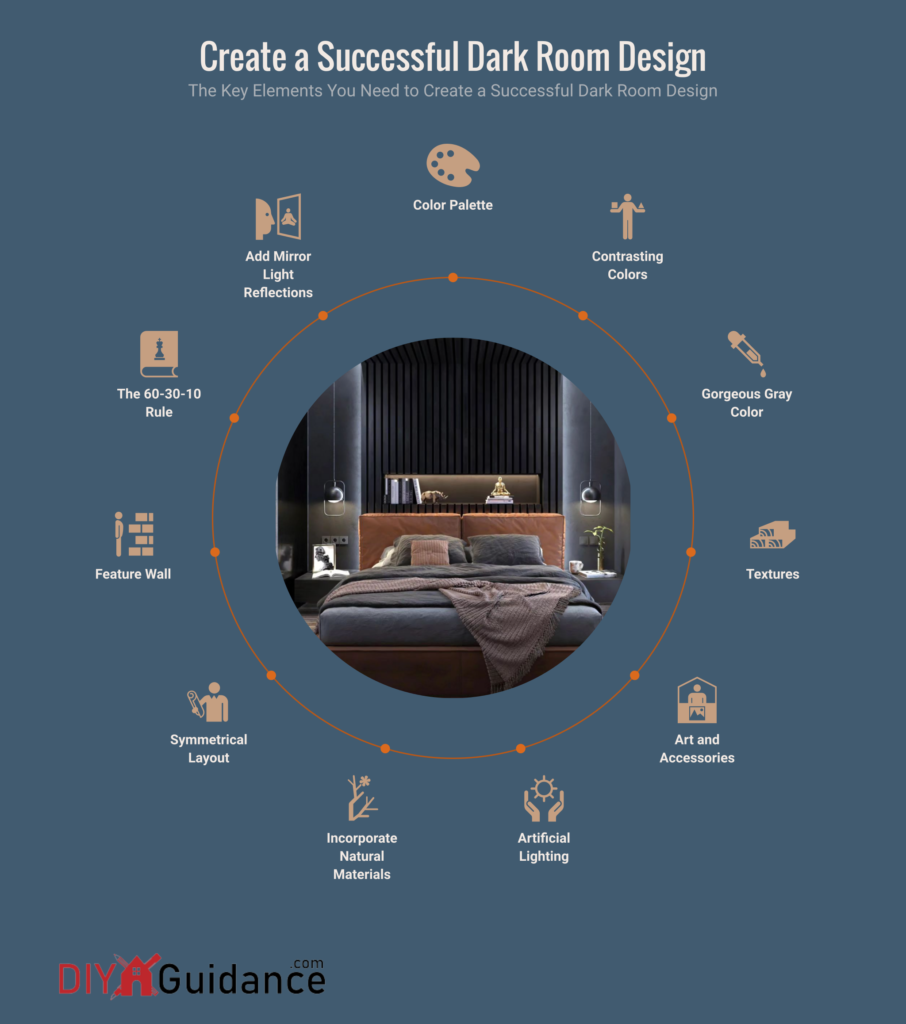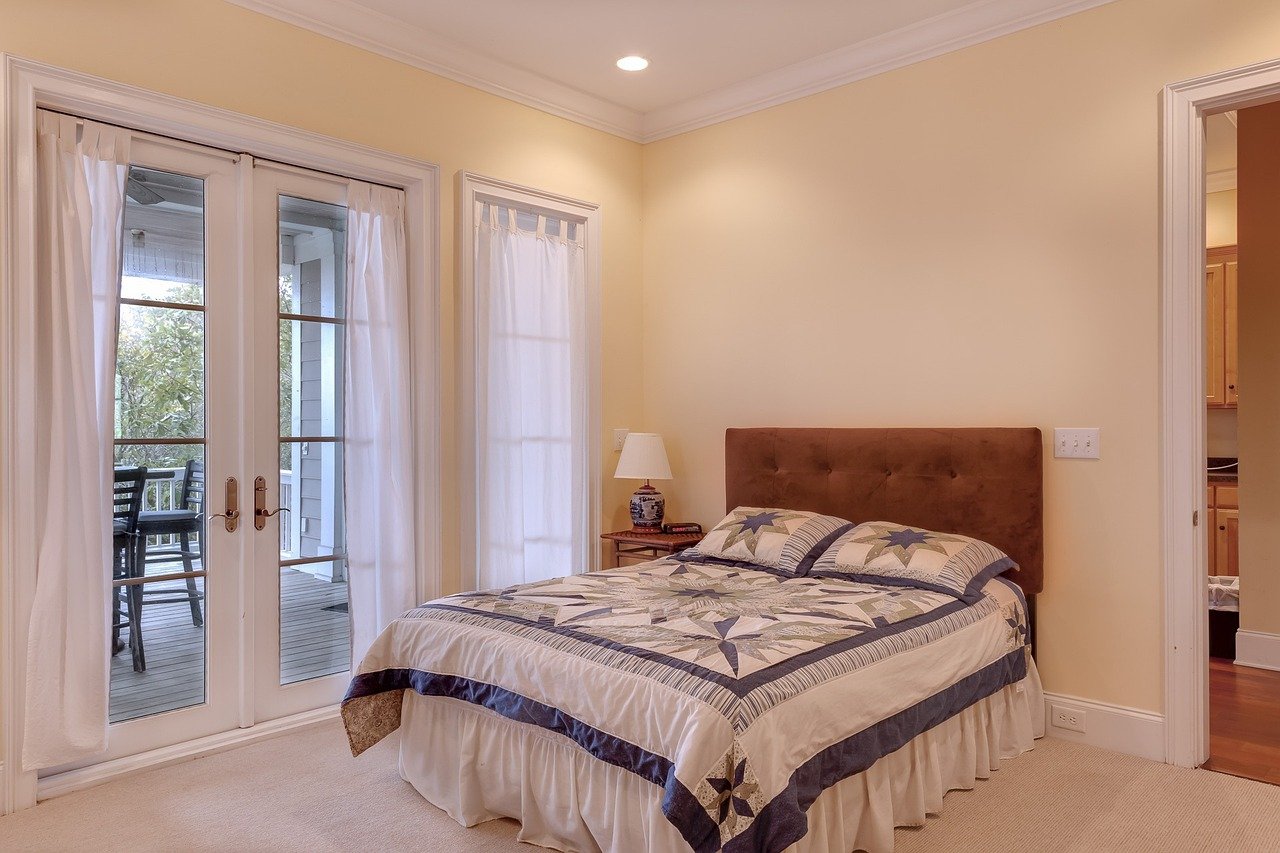Have you ever heard of the term “dark room design“? It’s not a term commonly thrown around in home decor conversations, but it’s definitely worth considering if you’re looking to create a dramatic and moody space.
A dark room design embraces dark colors, rich textures, and ambient lighting to create a cozy and intimate atmosphere. Think matte black walls, velvet upholstery, and dimly lit lamps. It’s a way to create a luxurious and inviting environment without relying on bright, bold colors.
So if you want to create a dark room design in your home, in this guide, I will give you all the information you need to get started, including tips on how to choose colors, add texture, and light your space.
What is a Dark Room Design?

Darkroom design is exactly how it sounds – using dark colors to create drama and mood in a room. It involves subduing bright and bold colors and using dark and muted tones instead. You can achieve this by incorporating dark-colored furniture, window treatments, wall paint colors, or home decor accessories such as throw pillows and rugs. One crucial aspect to keep in mind is the natural light source in your home. If you want to give your space a cozier feel, blocking out natural light with blackout curtains or shades can give you that desired look and feel.
But how can a dark room design transform your home, and why might it be worth considering for your next decor update?
1: Creates Atmosphere:
One of the main reasons why dark room design is so popular is because it creates a particular atmosphere in your home. Deep, moody colors like navy blue, forest green, and charcoal gray can make a space feel cozy, intimate, and calming. In contrast, lighter colors create a more open and airy atmosphere, which can be refreshing but not necessarily cozy. Plus, darker colors can make a room feel more luxurious and expensive, adding a sense of depth and richness that lighter colors don’t have.
2: Adds Visual Interest:
Another great benefit of dark room design is that it adds much visual interest to your home. By using darker colors on your walls, floors, or furniture, you can create a statement piece that draws the eye and adds texture to your decor. Plus, you can use darker colors to play with shadows and light, creating a more dynamic and engaging space. Just imagine how stunning a deep blue accent wall would look with a few strategically placed lamps shining on it!
3: Hides Imperfections:
Dark room design isn’t just all about aesthetics, either – it can also be practical. Using darker colors in a room can help hide imperfections, like scuff marks or stains on the walls or floors. Plus, darker colors are less likely to show wear and tear, so your decor will look newer for longer. So dark room design might be the way to go if you have kids or pets or are prone to making messes.
4: Easy to Accessorize:
Since darker colors are so versatile, they go with almost any other color you want to add to your decor. You can go for a monochrome look with shades of black, gray, and charcoal, or you can add pops of color with bright, bold accents like mustard, yellow, or magenta. Moreover, you can experiment with different colors and textures until you find the perfect balance for your space.
5: Trending Design:
It’s worth noting that dark room design is very much on-trend right now. Many interior designers and home decor enthusiasts embrace darker colors and textures in their designs, which can be absolutely stunning. Whether you want a rustic, moody vibe or a sleek and sophisticated look, you can incorporate dark room design into your home decor. Plus, with many different colors and textures, you can make the trend your own and create a unique, personalized space.
6: Improve Sleep Quality:
Aside from the aesthetic appeal, dark room design can also lead to better sleep. Using darker colors and blocking natural light in a bedroom can create a calming atmosphere that is perfect for winding down after a long day. It can help reduce distractions since lighter colors draw the eye more easily. A dark room design is a perfect solution if you struggle to fall asleep or stay asleep at night.
The Elements of Creating a Dark Room Design

If you’re a fan of moody atmospheres and dramatic flair, a dark room design might be right up your alley. Whether you’re looking to create a cozy, intimate space or a bold, artsy statement, there are plenty of ways to add depth and drama to your decor. But how do you strike the right balance and avoid making your space feel too gloomy or oppressive? I will share the key elements you need to create a successful dark room design.
👉Color Palette
One of the most important elements of a dark room design is, of course, the color scheme. Generally, you’ll want to stick to darker colors like black, navy, and dark grey, but don’t be afraid to add in some pops of bold color to keep things interesting. Deep jewel tones like emerald green, sapphire blue, and amethyst purple work particularly well in this context. Regarding neutrals, look for warm, earthy tones like rust, ochre, and chocolate brown rather than cool shades like white or beige.
👉Contrasting Colors
A dark room is not limited to black or navy; there are various dark shades, such as maroon, emerald, and olive green. The key to making these colors work is to pair them with contrasting colors that accentuate their beauty. For instance, combining a black wall with a yellow decorative piece makes the latter stand out. Another example is pairing gray with pastel or bright hues. This simple trick will make your room more vibrant and break the monotony of dark color.
👉Gorgeous Gray Color
Gray is a timeless color that creates a luxurious look. Though it may seem dull, it can be stylish if you combine it with other colors and textures. One way to use gray is by creating an accent wall that highlights a particular design element. You can also use different hues of gray to create depth and contrast. In addition, mixing gray with dark wood or metal creates a chic, industrial ambiance.
👉Textures
In order to add depth and interest to your dark room design, you’ll want to incorporate a range of textures. Think plush velvet sofas, chunky knit throws, and rough-hewn wood accents. Furry rugs and sheepskins also add tactile softness to your space. Regarding patterns, look for bold prints like stripes or geometric shapes rather than busy florals.
👉Art and Accessories
Don’t forget to add personality to your space with the right accessories and wall art. For a dark room design, you might want to lean into some more eclectic or bohemian styles. Look for vintage elements like antique mirrors or quirky sculptures. When it comes to artwork, go for pieces with a moody vibe, like abstract paintings with deep shades of blue or black and white photographs.
👉Artificial Lighting
Lighting can make or break a room, especially in dark spaces. Artificial lighting can help set the mood and ambiance of your room. Dimmer switches or a mixture of lighting options, such as ceiling lights and table lamps, can create different moods to suit the occasion. For instance, dimming your lights will create a perfect atmosphere for movie nights. Adding pendant lights with a warm glow and metallic finishes will provide a soft glow and elevate the room’s luxury ambiance.
👉Incorporate Natural Materials
Dark rooms tend to be gloomy and, sometimes, even oppressive. In order to counterbalance this, it’s essential to introduce natural materials to the space. Wood, stone, and plants are fantastic accents to bring in natural textures and colors. A wooden side table or a stone fireplace can significantly impact the room’s ambiance. You can also introduce plants to the space to add greenery and improve air quality. Hanging plants like Devil’s Ivy or Pothos are excellent choices as they thrive in low-light areas.
👉Symmetrical Layout
Symmetry is a powerful tool when it comes to interior design. A well-planned and balanced symmetrical layout can create a calm and peaceful atmosphere. You can use this design approach for a dark room to make the space look more organized and spacious. A beloved example of this is symmetry can be a pair of matching armchairs with a wooden coffee table or a set of identical lamps on either side of the bed.
👉Feature Wall
Using a feature wall can bring an interesting dimension to a dark space. You can paint this wall in a bold color or cover it in textured or patterned wallpaper. Dark colors like navy blue, forest green, or dark grey can add depth to space. If you are hesitant to go all-in with a bold color, choose a pattern or texture that suits your preferences or personality, and work with its color palette.
👉The 60-30-10 Rule
Have you ever heard of the 60-30-10 color rule? It’s a guideline that designers use to create visually pleasing color combinations. The rule states that you should use 60% of one color, 30% of another complementary color, and the last 10% should be an accent color that pops. When designing a dark room, it’s essential to choose colors that complement each other, or you risk making the space feel too overwhelming or dull. Try playing with color themes in the room using this rule, and you’ll be surprised at how much it can change the entire look and feel of the space.
👉Add Mirror Light Reflections
Another way to bring more light into a dark room is to use mirrors to reflect light around the space. Mirrors can create an illusion of more significant space and brighter lighting when used correctly. Place mirrors opposite windows or light fixtures to maximize this effect. You can also experiment with different mirror shapes and sizes to create a unique focal point. Mirrors can also create a bold statement in the room and add a layer of visual interest.
By following these tips, you can transform your dark room into an inviting oasis with plenty of character and charm.
Frequently Asked Questions
Why is a dark room better?
If a room is so bright, it feels like the sun is shining right in your eyes. It’s not exactly the most comfortable experience. That’s why I personally prefer a dark room design. Minimizing the amount of natural light in a space creates a cozy atmosphere perfect for relaxing and unwinding after a long day. Plus, a dark room allows you to control the lighting better and set the mood according to whatever you want. Whether you want to curl up with a good book or binge-watch your favorite TV show, a dark room provides the perfect backdrop. It might not be for everyone, but for those of us who enjoy a little bit of contrast in our lives, a dark room is the way to go.
How does a dark room affect your mood?
A dark room can be incredibly calming and soothing. Without being constantly bombarded by bright lights, you’re free to relax and unwind without any distractions. Even subtle light sources like candles can create a cozy atmosphere conducive to restful sleep or quiet contemplation. Dark rooms also provide an opportunity for personal expression—you can create whatever mood you want in a dark room, whether romantic, mysterious, or dramatic.
Is a dark room good for health?
Yes, a dark room can benefit your health as it helps reduce stress and promote relaxation. The darker the environment, the more restful sleep you will get. Additionally, having a dimmer light in your surroundings implies that the blue light emitting from your screen won’t disrupt your body’s internal clock, helping you wake up feeling refreshed and energized in the morning.
Can a dark room make you sleepy?
Yes, a dark room can make you sleepy. Without bright lights stimulating your senses, the environment becomes much more conducive to rest and relaxation. Plus, using light-blocking curtains or shades to make the room as dark as possible will further help your body recognize that it is time for sleep. Ensure also to reduce noise levels and create a comfortable temperature before settling in for the night.
How do you get sunlight in a dark room?
If you want to increase the amount of natural light in a dark room, start by using sheer curtains or blinds that will allow more sunlight without compromising privacy. Try moving furniture away from windows to maximize the amount of light entering your space. You can also use mirrors to reflect existing light sources around the room and make it appear brighter.
Final Words
After diving into dark room design, I can confidently say it’s a game changer. Being able to control the light, shadows, and overall mood of a space is truly eye-opening. It’s like stepping into a different universe where everything is subtle, transcendent, and thought-provoking. A dark room design can create a mesmerizing atmosphere that pulls you in and allows you to escape from the chaos of the outside world. It doesn’t have to be gloomy, either. So, check the tips above and start transforming your own dark room with plenty of character and appeal.


